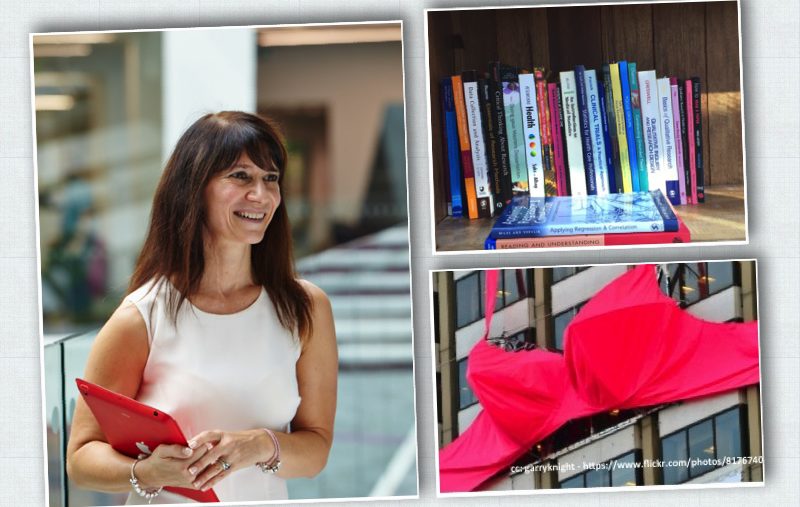 I am a wife and mother, and also a Professor of Radiotherapy and Oncology. I trained as a therapy radiographer at the Royal London Hospital (London, Whitechapel) from 1984-1987. Shortly after qualifying as a therapy radiographer I returned to Yorkshire to work at Cookridge Hospital in Leeds. I worked on all aspects of radiation treatment but specialised in pre-treatment imaging. I undertook my PhD while working as a specialist therapy radiographer investigating the local radiotherapy protocol for breast cancer. At the end of my PhD and after 14 years with the NHS I joined academia to pursue my interest in research.
I am a wife and mother, and also a Professor of Radiotherapy and Oncology. I trained as a therapy radiographer at the Royal London Hospital (London, Whitechapel) from 1984-1987. Shortly after qualifying as a therapy radiographer I returned to Yorkshire to work at Cookridge Hospital in Leeds. I worked on all aspects of radiation treatment but specialised in pre-treatment imaging. I undertook my PhD while working as a specialist therapy radiographer investigating the local radiotherapy protocol for breast cancer. At the end of my PhD and after 14 years with the NHS I joined academia to pursue my interest in research.
I am passionate about the use of evidence based practice within healthcare and have championed research activity within my own profession for over fifteen years. I have led inter-professional research methods teaching for healthcare students, I supervise under-graduate and post-graduate student research projects and run research workshops. My research includes both qualitative and quantitative research methods. My research interests have included studies to develop the oncology workforce (including investigations of burnout and development of resilience). However, my main interest centres on research to improve the quality of radiotherapy for patients diagnosed with breast cancer, specifically aiming to improve accuracy of treatment, patient care and the patient experience.
Breast Cancer
Today in the UK 150 women will be told they have breast cancer, with over 464,000 women diagnosed with the disease in Europe alone in 2012. Breast cancer is the most common cancer in women, 1 in 8 women will be diagnosed with this disease during their lifetime (Cancer Research UK), this also means that 7 out of 8 women won’t. It is also important to note that more women than ever are surviving breast cancer (more than 80% of women will survive breast cancer beyond five years with around 78% surviving more than ten years (Breast Cancer Care). This means there is a need to look at how we treat women with breast cancer in order to improve the treatment experience and also improve the quality of life for women following breast cancer treatment- please see our Support 4 All website for information on our current research.
Breast Awareness and Breast Health
- To promote breast health you should consider undertaking breast self examination.
- It is helpful to be familiar with how your breasts feel at different parts of the menstrual cycle (i.e. at different times of the month).
- With practice self examination can help you become familiar with what is normal, so if there is a change in your breasts you are more likely to be able to detect it.
1.Know what’s normal for you
2.Look at your breasts and feel them
3.Know what changes to look for
4.Report any changes without delay.
If you find a lump that you haven’t felt before remember under the age of 30 years breast cancer is rare, but it is always important to get anything unusual checked by your GP.This infographic from Breast cancer Care helps to show what to look for when examining your breasts. Know the risk factors, take a look at the excellent Breast Cancer Care web resources. One of the biggest risks for developing breast cancer is older age (risk increases with age). So is there anything you can do to lower your risk of developing breast cancer when you get older? Yes you can, research shows:
1.Decreasing your intake of alcohol can decrease your risk of developing breast cancer later in life. Knowing what is a safe alcohol limit for good health in general is difficult, this is even more difficult when considering breast cancer risk, this blog by Cancer Research UK (CRUK) maybe helpful, stick with it, it is a difficult area to explain and CRUK do it very well.
2.Moderate exercise and maintaining a healthy weight can help to reduce the risk of developing breast cancer when you are older.
Looking after your breasts for the rest of your life-Reducing breast sagging
The breasts become less glandular with age and fattier and with time this means they are less firm. Factors thought to influence the extent of breast sagging with age include:
- A woman’s pre-pregnancy cup size (not much you can do about this one)
- A large number of pregnancies
- Cigarette smoking- this weakens skin elasticity- another good reason to give up smoking right there.
- Stretching of the ligaments in the breasts (Coopers Ligaments)
Wearing a good fitting bra during exercise may reduce the stretching of Coopers Ligaments.

I am high risk as my mum nana and auntie all had breast cancer. I found all of the above interesting and informative. Thank you x
LikeLiked by 1 person
Sorry to hear that Liesl, it’s good to be aware and keep being monitored X
LikeLike
Do you know Dr @Liz_ORiordan ? https://liz.oriordan.co.uk/
LikeLike
Yes I do know the wonderful Liz.
LikeLike
I appreciate this information about early detection and research for improving treatment outcomes in breast cancer.
LikeLike